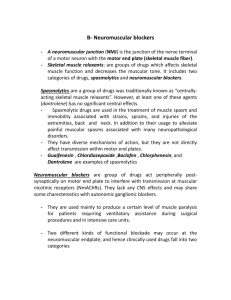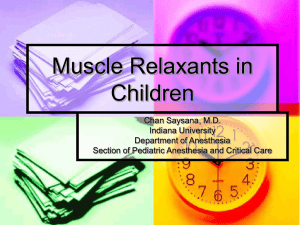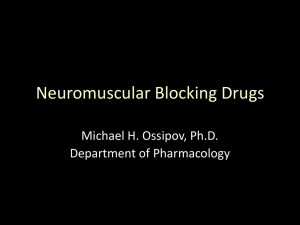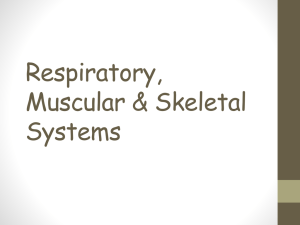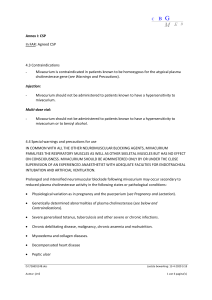1-skeletal muscle relaxants-2014 December
advertisement
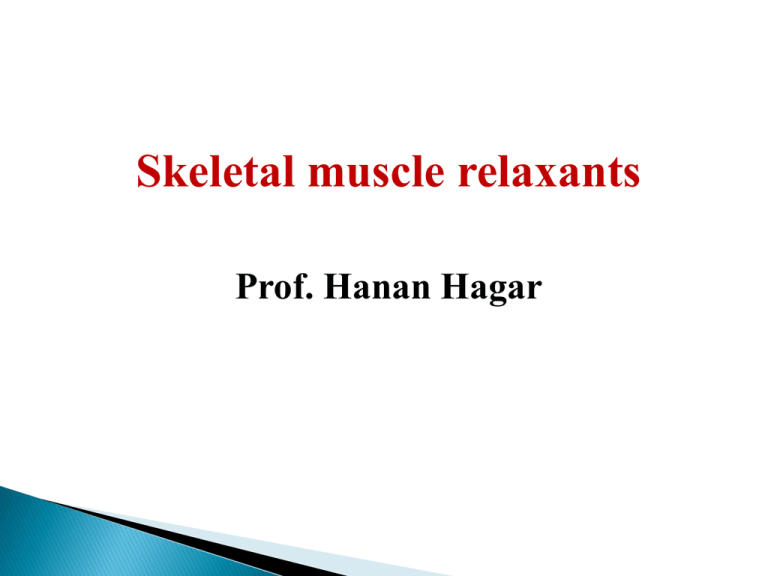
Skeletal muscle relaxants Prof. Hanan Hagar Learning objectives By the end of this lecture, students should be able to: - - Identify classification of skeletal muscle relaxants Describe the pharmacokinetics and dynamics of neuromuscular relaxants Recognize the clinical applications for neuromuscular blockers Know the different types of spasmolytics Describe the pharmacokinetics and dynamics of spasmolytic drugs Recognize the clinical applications for spasmolytic drugs Skeletal muscle relaxants Are drugs used to induce muscle relaxation Classification of SKM relaxants Peripherally Centrally acting skeletal muscle relaxants acting skeletal muscle relaxants e.g. Baclofen – Diazepam Direct acting skeletal muscle relaxants e.g. Dantrolene Peripheral acting SKM relaxants Neuromuscular blockers Neuromuscular blockers act by blocking neuromuscular junction or motor end plate leading to skeletal muscle relaxation. Classification of Neuromuscular blockers According to mechanism of action, they are classified into: 1. Competitive neuromuscular blockers (nondepolarizing) 2. Depolarizing neuromuscular blockers Competitive neuromuscular blockers Mechanism of action: Compete with Ach for the nicotinic receptors present in postjunctional membrane of neuromuscular junction or motor end plate. No depolarization of postjunctional membrane Neuromuscular Junction Have the suffix curium or curonium Classified according to duration of action into: Atracurium Mivacurium Pancuronium Vecuronium Long acting ◦ d-tubocurarine (prototype drug) ◦ Pancuronium Intermediate acting ◦ Atracurium Vecuronium Short acting ◦ Mivacurium Pharmacokinetics of competitive NM blockers They are polar compounds Inactive orally & taken parentrally Do not cross BBB (no central action) Do not cross placenta Metabolism depend upon kidney or liver Except Mivacurium (degraded by acetyl cholinesterase ) Atracurium (spontaneous degradation in blood) Pharmacological actions of competitive NMBs: Skeletal muscle relaxation. They produce different effects on CVS Some release histamine and produce hypotension o d-Tubocurarine o Atracurium o Mivacurium Others produce tachycardia ( H.R) o Pancuronium d – Tubocurarine Long duration of action (1 - 2 h) Eliminated by Not kidney 60% - liver 40%. used clinically due to adverse effects: Histamine releaser leading to Bronchospasm (constriction of bronchial smooth muscles). Hypotension Tachycardia More safer derivatives are now available Atracurium As potent as curare Has intermediate duration of action (30 min). Liberate histamine (Transient hypotension) Eliminated by non enzymatic chemical degradation in plasma (spontaneous hydrolysis at body pH). used in liver failure & kidney failure (drug of choice). Should be avoided in asthmatic patients Why? Mivacurium Chemically related to atracurium Fast onset of action Has the shortest duration of action (15 min) of all competitive neuromuscular blockers. Metabolized by pseudo-cholinesterase. Longer duration in patient with liver disease or genetic cholinesterase deficiency or malnutrition. Transient hypotension (due to histamine release). Pancuronium More potent than curare (6 times). Excreted by the kidney ( 80 % ). Long duration of action. Side effects: Hypertension, tachycardia ◦ NE release from adrenergic nerve endings. ◦ Antimuscarinic action (block parasympathetic action). ◦Avoid in patient with coronary diseases. Vecuronium More potent than tubocurarine (6 times). Metabolized mainly by liver and excreted in bile. Intermediate duration of action. Has few side effects. No histamine release. No tachycardia. Depolarizing Neuromuscular Blockers Mechanism of action combine with nicotinic receptors in postjunctional membrane of neuromuscular junction initial depolarization of motor end plate muscle twitching persistent depolarization SKM relaxation Succinylcholine (suxamethonium) Pharmacological Actions 1. SK. muscles : twitching relaxation 2. Hyperkalemia : Cardiac arrest. 3. 4. Eye : intraocular pressure (due to contraction of extra-ocular muscle). CVS : arrhythmia Pharmacokinetics Fast onset of action (1 min.). Short duration of action (5-10 min.). Metabolized by pseudo-cholinesterase in plasma Half life is prolonged in ◦ Neonates ◦ Elderly ◦ Pseudo-cholinesterase deficiency (liver disease or malnutrition or genetic cholinesterase deficiency). Side Effects Hyperkalemia CVS arrhythmia Intraocular pressure contraindicated in glaucoma Can produce malignant hyperthermia May cause succinylcholine apnea due to deficiency of pseudo-cholinesterase. Is a rare inherited condition that occurs upon administration of drugs as: ◦ general anesthesia e.g. halothane ◦ neuromuscular blockers e.g. succinylcholine Inability to bind calcium by sarcoplasmic reticulum in some patients due to genetic defect. Ca release, intense muscle spasm, hyperthermia Drug Duration Side effects Notes Tubocurarine Long 1-2 h Hypotension # Renal failure Pancuronium Long 1-2 h Tachycardia # Renal failure Transient hypotension Histamine release Spontaneous degradation Used in liver and kidney failure Few side effects # Liver failure Atracurium Short 30 min. Vecuronium Short 40 min. Mivacurium Short 15 min. Succinyl choline Short 10 min. Similar to atracurium Hyperkalemia Arrhythmia Increase IOP Metabolized by pseudocholinesterase # Choline esterase deficiency # CVS Diseases # Glaucoma # Liver disease Uses of neuromuscular blockers control convulsion electroshock therapy in psychotic patients. Relieve of tetanus and epileptic convulsion. As adjuvant in general anesthesia to induce muscle relaxation Facilitate endotracheal intubation Orthopedic surgery. Drugs and diseases that modify effects of neuromuscular blockers Diseases such as myasthenia gravis can modify the response to muscle relaxants. Drugs as aminoglycosides (e.g. streptomycin), magnesium sulphate, general anesthetics can potentiate or enhance the effect of neuromuscular blockers. Spasmolytics They reduce muscle spasm in spastic states Baclofen: Centrally acting GABA agonist – acts on spinal cord. Diazepam (Benzodiazepines): Centrally acting facilitate GABA action on CNS. Dantrolene: direct action on skeletal muscles. Dantrolene Mechanism of action Acts directly on skeletal muscles. It interferes with the release of calcium from its stores in skeletal muscles (sarcoplasmic reticulum). It inhibits excitation-contraction coupling in the muscle fiber. Orally, IV, (t ½ = 8 - 9 h). Used in the treatment of: Spastic states Malignant hyperthermia Uses of spasmolytics They reduce muscle spasm in spastic states produced by neurological disorders as: • Spinal cord injury • Cerebral stroke • Cerebral palsy
